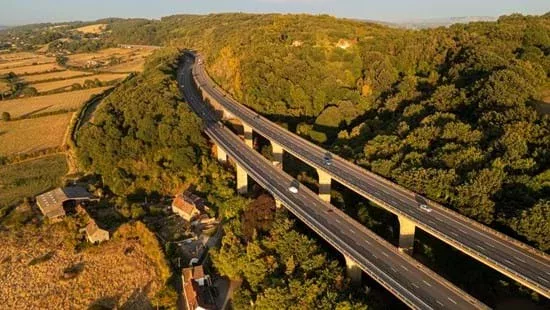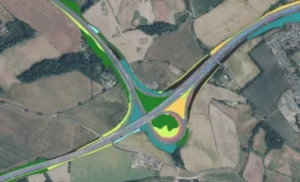Timed to mark UN Biodiversity Day this week, the government’s strategic roads operator is highlighting nature focused work by the company and partners around the country.
It comes as National Highways unveils ambitious plans to deliver a more sustainable road network that not only connects the country but also protects and enhances the environment over the next three decades.
National Highways’ Environmental Sustainability Strategy (published 18 May) sets out the company’s vision for: A connected country. A thriving environment.
The company’s ambition is to not only mitigate the impact of England’s busiest roads but ensure they can be used as a force for good for generations to come.
As one of the country’s largest landowners with 30,000 hectares of green land, it is vital that National Highways commits to using its green land to reconnect habitats, reverse the decline in biodiversity, help wildlife thrive and build in environmental resilience to a changing climate.
Roadside verges and nearby land and wetlands alone are home to a diverse array of plants, animals and natural habitats.
The new Environmental Sustainability Strategy lays out National Highways’:
- Long-term commitments to benefit the environment;
- Plans to protect and enhance nature, reaffirm the commitment to net zero carbon and tackle local environment impacts for the benefit of communities;
- Examples of improvements to the quality and connectivity of landscape and habitats;
- The strategy makes a series of major commitments to map out a green future for the 4,500-mile network with a focus on three key areas – the protection and enhancement of nature, carbon reduction and support for community health and wellbeing.
This includes using land to reconnect habitats that have been severed around and adjacent to the network, contributing to the national effort to reverse the decline in biodiversity, helping wildlife thrive by providing quality habitats, and building environmental resilience to a changing climate through initiatives such as natural flood management.
It also commits to investing in measures to remove carbon from the network, support the transfer to zero-emission vehicles, develop new ways to reduce pollution and enhance historic and cultural features on, or close to, major roads.
Tailored solutions that could be delivered as part of the plan include:
- Erecting solar panels on noise barriers as part of a wider commitment to deliver renewable energy to the network;
- Introducing wetlands for natural flood management;
- Improving the visibility of heritage features from the road;
- Improve all the SSSIs;
- Improve all Sites of Special Scientific Interest (SSSIs) in our ownership and support wider enhancement where we can;
- Taking action to address high-risk outfalls, improving the quality of water being discharged from the network into nearby rivers;
- Connecting natural habitats on either side of a road by adapting existing bridges and underpasses and installing new features, such as green bridges, where beneficial.
The company will also seek to minimise particulate air, water and noise pollution through research and innovative design solutions which could include better construction materials to help to reduce emissions at the tyre-road interface.
National Highways’ network of motorways and major A-roads forms the backbone of the transport system and represents one of the UK’s most important pieces of national infrastructure. It links families and friends as well as transporting 79 per cent of freight goods across the length and breadth of the country.
Nick Harris, National Highways’ Chief Executive, said: “Most journeys will still be made by road in 2050 so it is more important than ever that we manage our network in a way that balances the needs of today with those of tomorrow.
“This is why we are passionate about making our network as environmentally sustainable as it can be. From the air that we breathe to the natural resources that we use to create and innovate; our economy, health and wellbeing depend upon a thriving environment.
“With 4,500 miles of motorways and major A-roads, we are uniquely placed to play an active and positive role in achieving this, ensuring that our network can be a force for good.”
The strategy acknowledges the environmental impact of the network, which has been developed over the last 60 years, causing severance issues for nearby communities, fragmenting habitats, altering waterways and affecting the natural characteristic of the surrounding landscape.
The 4 million journeys supported on the network each day have also contributed to the UK’s carbon emissions while also generating noise, air and water pollution.
National Highways is already taking action to address these issues. It is the first major roads organisation to achieve a globally-recognised accreditation – PAS 2080 – for its carbon management system to reduce carbon in its design, construction and operation of roads.
Plans published in 2021 committed National Highways to eliminate carbon from its own operations by 2030, and to achieve net zero construction and maintenance by 2040. In partnership with wider organisations, industry and government, the whole network will be emission-free by 2050 through measures such as the roll-out of zero-emission vehicles.
Other recent milestones include mitigating the impact of noise pollution on more than 9,000 households, delivering 95 biodiversity schemes and improved flood resistance at more than 100 vulnerable locations.
However, National Highways recognises that it can only achieve so much on its own and environmental enhancements can be delivered on a far broader scale by working with communities, and partnering with landowners and environmental groups.
It also supports government goals around environmental performance as set out in the 2023 Environmental Improvement Plan.
During the week National Highways will be highlighting a diverse range of work such as:
- Announcing funding for a new partnership with environmental charity Plantlife for two ‘Meadow Makers’ grasslands projects;
- Outlining some of the work conducted on the Historical Railways Estate, which is a haven for many species of native wildlife. The ecological work on the Historical Railways Estate forms part of our ongoing commitment to support and improve biodiversity across the land, projects and sites that we manage;
- Casting a spotlight on the rare and interesting diversity of wildlife found on the verges and green lands next to motorways and major A roads;
- Highlighting some of the grasslands and wildflower planting schemes that have boosted biodiversity across the country;
- Drawing attention to the damaging impact of litter to wildlife and the environment;
- Sharing partnership schemes that have created valuable habitats for birds;
- Providing an update from local Wildlife Trusts schemes on the Network for Nature programme of biodiversity projects close to the strategic road network.





















